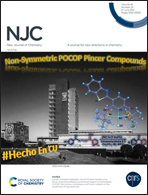High shear vortex fluidic morphologically controlled polysulfone formed under anhydrous conditions†‡
Abstract
Polysulfone (PSF) was prepared under anhydrous conditions, under high shear in a vortex fluidic device (VFD) operating under confined mode, in DMSO, thereby avoiding the use of chlorinated solvents, unlike in conventional batch processing in generating the polymer. The effect of systematically varying the operational parameters of the VFD (rotational speed (ω) and tilt angle (θ) of the 20 mm diameter quartz tube housed in the device, and temperature and processing time) was investigated with respect to MW and Tg of the polymer, with the product further characterised using FTIR, NMR, GPC, DSC, SEM and BET. As a comparison, for the optimal processing parameters (ω 6k rpm, θ 45°, t 160 °C, T 60 min), the MW and Tg, ∼16 kg mol−1 and ∼170 °C respectively, were significantly increased relative to those prepared without exclusion of moisture, ∼6.7 kg mol−1 and ∼154 °C respectively. SEM established that increasing ω resulted in different morphologies of the PSF, forming sheet-like structures at lower rotational speeds then pseudo-spherical structures followed by a mixture of sheet-like and rod-shape structures for increasing ω. Change in temperature of the reaction also impacted on the nature of the product, with sheet-like structures formed at 140 °C and fibrous material at 170 °C. BET findings correlated with SEM images with a higher surface area for fibrous material, ∼4000 m2 g−1, compared to ∼1470 m2 g−1 for the sheet-like structures. The different morphologies arising from change in ω and temperature relate to different topological fluid flows in the VFD.



 Please wait while we load your content...
Please wait while we load your content...